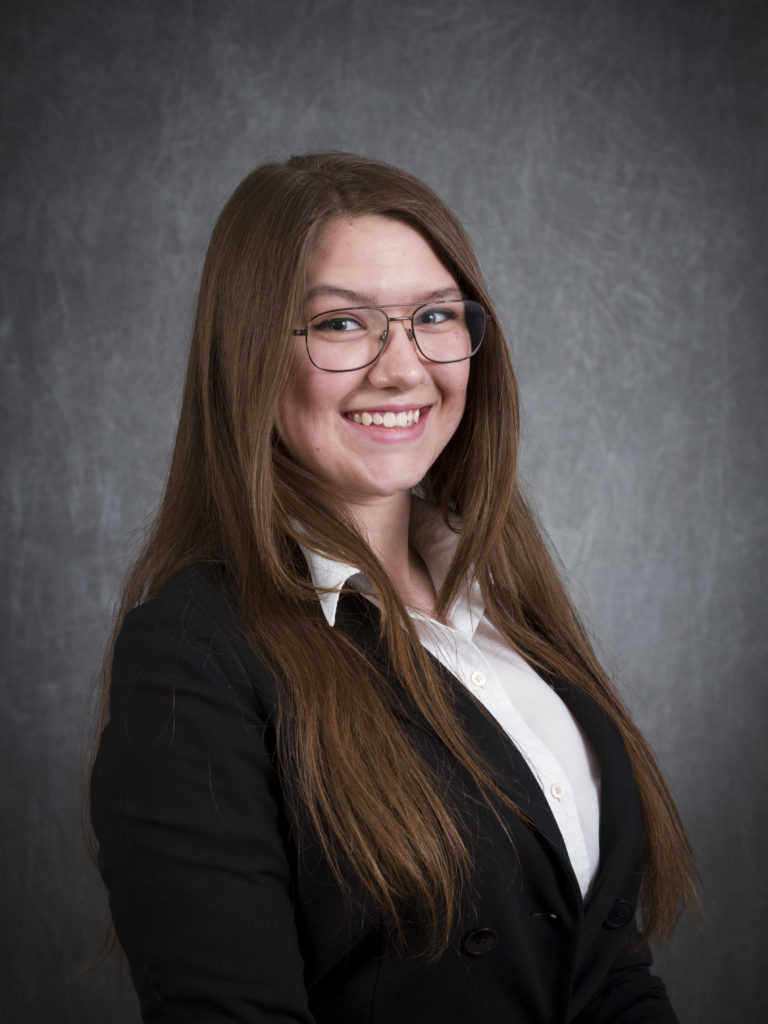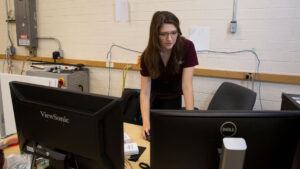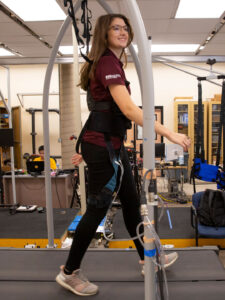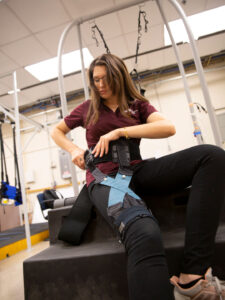Lily Catherine Baye-Wallace
Robotics and autonomous systems
Hometown: Phoenix, Arizona, United States
Graduation date: Fall 2021

MORE | Summer 2021
A Soft Robotic Hip Exosuit (SR-HExo) to Enable Entrainment during Human Locomotion
Over 7 million American stroke survivors require gait rehabilitation due to initial or persistent mobility deficits. Expansion of the “basin of entrainment” is a rehabilitative practice that improves gait uniformity through the application of small, periodic, mechanical perturbations to which the human locomotor system then synchronizes. A soft hip exosuit was developed to administer these precise perturbations at the front or back of the hip via a pair of lightweight, flat fabric pneumatic actuators orientated in X’s. The exosuit successfully expanded the basin of entrainment for 11 healthy participants by 15% through perturbations applied with either set of actuators.
Mentor: Hyunglae Lee
Featured project | Summer 2021
Lily Baye-Wallace, a robotics and autonomous systems graduate student focusing on mechanical and aerospace engineering, is working on a MORE project with Associate Professor Hyunglae Lee to develop a soft robotic hip exosuit that can provide rehabilitative assistance. Baye-Wallace has even submitted a provisional patent from her research with support from ASU.
What made you want to get involved in MORE?
I met two students who had worked on soft robotic orthoses with Dr. Lee through the Society of Women Engineers ASU section and they absolutely loved the research. When I was beginning my search for an advisor for my master’s thesis, I met then-PhD candidate and now Dr. Carly Thalman while salsa dancing and learned that the next project she was going to start coincidentally needed an additional graduate student. I started working with her later that week.
How will your engineering research project impact the world?
This is the lightest robotic hip exosuit on the market and it’s incredibly affordable to manufacture, which could be groundbreaking in the realm of assistive and rehabilitative devices for hemiparesis patients (those experiencing partial loss of strength on one side of the body) from the perspective of cost. I’m excited to test the limits of its rehabilitative potential in our next internal study and hopefully clinical trials.
Did you have a particular “aha!” moment during your project?
Most hip-based robotics utilize either motor-driven rigid limbs or Bowden cables. Our pneumatic muscles for the exosuit are uniquely lightweight, but they also don’t automatically change their own amount of tension, which is pre-set in the fitting and can be adjusted between uses but not while a participant is actively walking. Orienting the actuators in an “X” shape was a big game-changer — it achieves a low-profile look and hugs the leg for maximum force transmission without getting in the way of natural hip motion.
How do you see this experience helping with your career?
It’s my desire to develop medical devices for a living, ideally wearables for rehabilitation — like this suit — but I would also love to try my hand at robotic prostheses and minimally invasive surgical robots. I’ve obtained an institutional review board clearance and have practiced the development and running of human suit studies, I’ve learned more about gait biomechanics and I’ve obtained straightforward practical skills like collecting surface electromyography data and motion capture. This has also been submitted for a provisional patent, which is a great credential to have while working for product design and test positions. I think of all these skills will be directly applicable to work in the design and testing of other wearable consumer devices.
Why should other students get involved in these Fulton Schools research programs?
FURI, MORE and GCSP are simple, straightforward ways to obtain funding to work on almost any engineering project of any scope. It makes paid research really accessible and gives you the opportunity to try new things out and see what you’re interested in. At this point, I’ve worked in three labs at ASU and I’m grateful I had the opportunity to obtain such a breadth of research experience.


